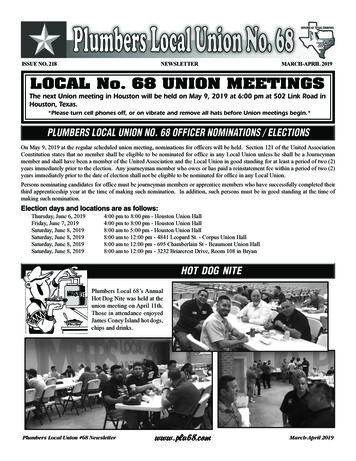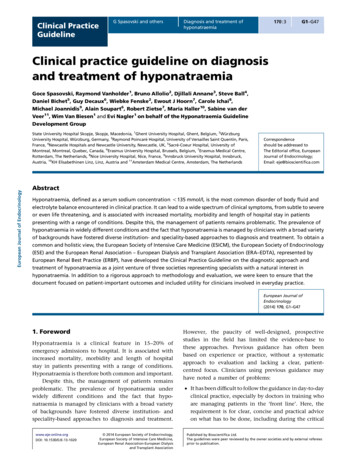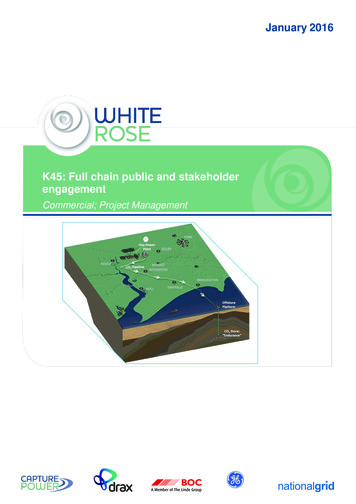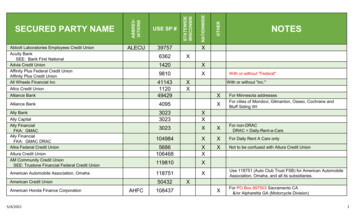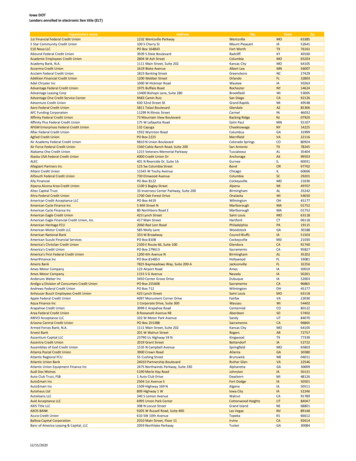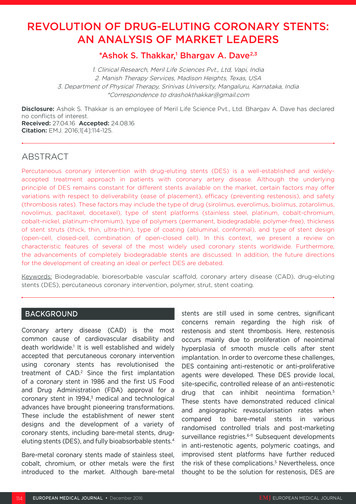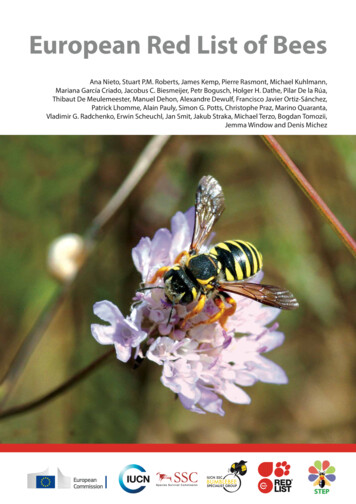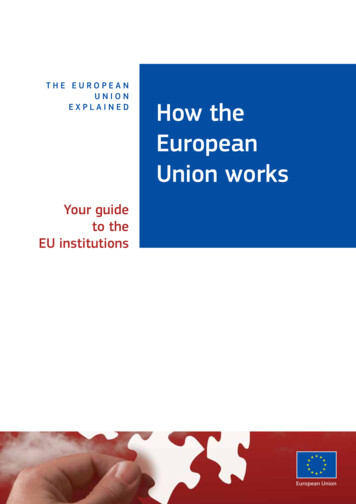
Transcription
THE EUROPEANUNIONEXPLAINEDYour guideto theEU institutionsHow theEuropeanUnion works
THE EUROPEAN UNIONEXPLAINEDThis publication is a part of a series that explainswhat the EU does in different policy areas,why the EU is involved and what the results are.You can find the publications online:http://europa.eu/pol/index en.htmhttp://europa.eu/!bY34KDHow the EU worksEurope in 12 lessonsEurope 2020: Europe’s growth strategyThe founding fathers of the EUAgricultureBanking and financeBorders and securityBudgetClimate actionCompetitionConsumersCulture and audiovisualCustomsDigital agendaEconomic and monetary union and the euroEducation, training, youth and sportEmployment and social affairsEnergyEnlargementEnterpriseEnvironmentFight against fraudFood safetyForeign affairs and security policyHumanitarian aid and civil protectionInternal marketInternational cooperation and developmentJustice, fundamental rights and equalityMaritime affairs and fisheriesMigration and asylumPublic healthRegional policyResearch and innovationTaxationTradeTransportThe European Union explained:How the EU worksEuropean CommissionDirectorate-General for CommunicationCitizens information1049 BrusselsBELGIUMManuscript updated in November 2014Cover: Luis Pedrosa44 pp. — 21 29.7 cmISBN 978-92-79-39909-1doi:10.2775/11255Luxembourg: Publications Officeof the European Union, 2014 European Union, 2014Reproduction is authorised. For any use or reproductionof individual photos, permission must be sought directlyfrom the copyright holders.
THE EUROPEANUNION EXPLAINEDHow theEuropeanUnion worksYour guideto theEU institutions
2H O WT H EE U R O P E A NU N I O NW O R K SContentsIntroducing the European Union: how it works, who does what . 3The European Parliament: the voice of the people . 9The European Council: setting the strategy . 12The Council: the voice of the Member States . 14The European Commission: promoting the common interest . 19The national parliaments: enforcing subsidiarity . 23The Court of Justice: upholding EU law . 24The European Central Bank: ensuring price stability . 26The European Court of Auditors: helping to improveEU financial management . 29The European Economic and Social Committee:the voice of civil society. 31The Committee of the Regions: the voice of local government . 33The European Ombudsman: investigating your complaints . 34The European Data Protection Supervisor: protecting your privacy . 35The European Investment Bank: investing in the future . 36The EU agencies . 38
Y O U RG U I D ET OT H EE U3I N S T I T U T I O N SIntroducing the European UnionHow it works, who does whatThis publication is a guide on how the European Union(EU) works. ‘How the EU works’ means how decisionsare taken at EU level and who takes those decisions. Atthe heart of this decision-making process are the EUinstitutions — such as the Parliament, the Council andthe European Commission — which you may haveheard of, and there are others. To show how the EUworks, this publication first explains how EU legislationis made. It then gives further insight into each of the EUinstitutions, as well as the agencies and bodiessupporting them.The European Union in briefAt the core of the EU are the Member States — the28 states that belong to the Union — and their citizens.The unique feature of the EU is that, although these areall sovereign, independent states, they have pooledsome of their ‘sovereignty’ in order to gain strength andthe benefits of size. Pooling sovereignty means, inpractice, that the Member States delegate some of theirdecision-making powers to the shared institutions theyhave created, so that decisions on specific matters ofjoint interest can be made democratically at Europeanlevel. The EU thus sits between the fully federal systemfound in the United States and the loose,intergovernmental cooperation system seen in theUnited Nations.The EU has achieved much since it was created in 1950.It has built a single market for goods and services thatspans 28 Member States with over 500 million citizensfree to move and settle where they wish. It created thesingle currency — the euro — which is now a majorworld currency and which makes the single marketmore efficient. It is also the largest supplier ofdevelopment and humanitarian aid programmes in theworld. These are just a few of the achievements so far.Looking ahead, the EU is working to get Europe out ofthe economic crisis. It is at the forefront of the fightagainst climate change and its consequences; it helpsneighbouring countries and continues ongoingnegotiations on enlargements; and it is building acommon foreign policy which will do much to extendEuropean values around the world. The success of theseambitions depends on the ability to take effective andtimely decisions and to implement them well.The EU treatiesThe European Union is based on the rule of law. Thismeans that every action taken by the EU is founded ontreaties that have been approved voluntarily anddemocratically by all EU countries. The treaties arenegotiated and agreed by all the EU Member States andthen ratified by their parliaments or by referendum.The treaties lay down the objectives of the EuropeanUnion, the rules for EU institutions, how decisions aremade and the relationship between the EU and itsMember States. They have been amended each timenew Member States have joined. From time to time,they have also been amended to reform the EuropeanUnion’s institutions and to give it new areas ofresponsibility. ImageGlobeWhat this publication is aboutOn 9 May 1950, French Foreign Minister Robert Schuman firstpublicly proposed the ideas that led to the European Union.So 9 May is celebrated as the EU’s birthday.
4H O WT H EE U R O P E A NU N I O NW O R K SThe last amending treaty — the Lisbon Treaty —was signed in Lisbon on 13 December 2007, andcame into force on 1 December 2009. Earlier treatiesare now incorporated into the current consolidatedversion, which comprises the Treaty on EuropeanUnion and the Treaty on the Functioning of theEuropean Union. ImageGlobeThe Treaty on Stability, Coordination and Governance(TSCG) in the Economic and Monetary Union is anintergovernmental treaty which was signed by all EUMember States except the Czech Republic and theUnited Kingdom in 2012 and entered into force on1 January 2013. It is not an EU treaty but anintergovernmental treaty, and the intention is to bringit into EU law. It obliges the countries to have firmrules to guarantee balanced public budgets and itstrengthens the governance of the euro area.The work of the EU is based on the treaties agreed byall the member countries — the latest main update wassigned in Lisbon in 2007.A history of the EU treatiesWhen French Foreign Minister Robert Schumanproposed integrating western Europe’s coal andsteel industries in 1950, his ideas were set out inthe Treaty of Paris the following year, and theprecursor to the EU — the European Coal and SteelCommunity — was born. Since then, the EU hasregularly updated and added to the treaties toensure effective policy and decision-making.XXXXXXThe Treaty of Paris, establishing the EuropeanCoal and Steel Community, was signed in Parison 18 April 1951 and entered into force in 1952.It expired in 2002.The Treaties of Rome, establishing the EuropeanEconomic Community (EEC) and the EuropeanAtomic Energy Community (Euratom), weresigned in Rome on 25 March 1957 and cameinto force in 1958.The Single European Act (SEA) was signed inFebruary 1986 and came into force in 1987. Itamended the EEC Treaty and paved the way forcompleting the single market.XXThe Treaty on European Union (TEU) — theMaastricht Treaty — was signed in Maastrichton 7 February 1992 and came into force in1993. It established the European Union, gavethe Parliament more say in decision-making andadded new policy areas of cooperation.XXThe Treaty of Amsterdam was signed on 2 October 1997 and came into force in 1999. Itamended previous treaties.XXThe Treaty of Nice was signed on 26 February2001 and entered into force in 2003. Itstreamlined the EU institutional system so thatit could continue to work effectively after thenew wave of Member States joined in 2004.XXThe Treaty of Lisbon was signed on 13 December 2007 and came into force in 2009. Itsimplified working methods and voting rules,created a President of the European Council andintroduced new structures with a view to makingthe EU a stronger actor on the global stage.
Y O U RG U I D ET OT H EE U5I N S T I T U T I O N SWho takes the decisions?XXA directive is a law that binds the Member States,or a group of Member States, to achieve a particularobjective. Usually, directives must be transposed intonational law to become effective. Significantly, adirective specifies the result to be achieved: it is upto the Member States individually to decide how thisis done.XXA decision can be addressed to Member States,groups of people, or even individuals. It is binding inits entirety. Decisions are used, for example, to ruleon proposed mergers between companies.XXRecommendations and opinions have no bindingforce.Decision-making at EU level involves various Europeaninstitutions, in particular:XXthe European Parliament, which represents theEU’s citizens and is directly elected by them;XXthe European Council, which consists of theHeads of State or Government of the EU MemberStates;XXthe Council, which represents the governments of theEU Member States;XXthe European Commission, which represents theinterests of the EU as a whole.The European Council defines the general politicaldirection and priorities of the EU but it does not exerciselegislative functions. Generally, it is the EuropeanCommission that proposes new laws and it is theEuropean Parliament and Council that adopt them.The Member States and the Commission thenimplement them.What types of legislation are there?There are several types of legal acts which are appliedin different ways.XXA regulation is a law that is applicable and bindingin all Member States directly. It does not need to bepassed into national law by the Member Statesalthough national laws may need to be changed toavoid conflicting with the regulation.How is legislation passed?Every European law is based on a specific treaty article,referred to as the ‘legal basis’ of the legislation. Thisdetermines which legislative procedure must befollowed. The treaty sets out the decision-makingprocess, including Commission proposals, successivereadings by the Council and Parliament, and theopinions of the advisory bodies. It also lays down whenunanimity is required, and when a qualified majority issufficient for the Council to adopt legislation.The great majority of EU legislation is adopted usingthe ordinary legislative procedure. In this procedure,the Parliament and the Council share legislative power.The procedure begins with the Commission. Whenconsidering launching a proposal for action, theCommission often invites views on the topic fromgovernments, business, civil society organisations and Heide Benser/CorbisThe freedom for all citizens totravel, live and work in all the28 EU countries is one of themain achievements of theEuropean Union.
6H O WT H EE U R O P E A NU N I O NW O R K SORDINARY LEGISLATIVE PROCEDURE1. Proposal from the Commission2. Opinions from national parliaments3. Opinions from the European Economic and Social Committee and/or the Committee of the Regions(when this is required)FIRST READING4. First reading by the European Parliament: Parliament adopts a position (amendments)5. Commission can amend its proposal6. First reading by the Council (*)7. Council approves Parliament’s position.The act is adopted8. Council and Parliament disagree on amendments.Council adopts position at first readingSECOND READING9. Second reading by the Parliament: Parliament approves the Council’s position at firstreading — the act is adopted in ‘early second reading’ — or proposes amendments10. Commission opinion on Parliament’s amendments11. Second reading by the Council (*)12. Council approves all Parliament’s amendments tothe Council’s position at first reading.The act is adopted13. Council and Parliament disagree on amendmentsto the Council’s position at first readingCONCILIATION14. Conciliation Committee is convened15. Conciliation Committee agrees on a joint text16. Parliament and Council agree with the proposalfrom the Conciliation Committee, andthe act is adopted17. Parliament and/or Council disagree with theproposal from the Conciliation Committee, andthe act is not adopted(*) Council adopts its position by a qualified majority (the treaties provide for unanimity in a few exceptional areas). However, if the Council intends to deviate from theCommission’s proposal/opinion it adopts its position by unanimity.
Y O U RG U I D ET OT H EE U7I N S T I T U T I O N Sindividuals. The opinions collected feed into aCommission proposal that is presented to the Counciland the Parliament. The proposal may have been madeat the invitation of the Council, the European Council,the Parliament or European citizens, or it may havebeen made on the Commission’s own initiative.The Council and the Parliament each read and discussthe proposal. If no agreement is reached at the secondreading, the proposal is put before a ‘conciliationcommittee’ comprising equal numbers of Council andParliament representatives. Commission representativesalso attend the committee meetings and contribute tothe discussions. Once the committee has reached anagreement, the agreed text is then sent to the Parliamentand the Council for a third reading, so that it can finallybe adopted as law. In most cases, the Parliament voteson proposals by simple majority and the Council byqualified majority voting, whereby at least half of thetotal number of EU Member States, representing abouttwo thirds of the population, must vote in favour. Insome cases, unanimous voting is required in the Council.Special proceduresSpecial legislative procedures are available dependingon the subject of the proposal. In the consultationprocedure, the Council is required to consult theParliament on a proposal from the Commission, but isnot required to accept the Parliament’s advice. Thisprocedure is only applicable in a few areas, such asinternal market exemptions and competition law. In theconsent procedure, the Parliament may accept orreject a proposal, but may not propose amendments.This procedure can be used when the proposal concernsthe approval of an international treaty that has beennegotiated. In addition, there are limited cases wherethe Council and the Commission, or the Commissionalone, can pass legislation.XXthe Committee of the Regions, which ensures thatthe voice of local and regional government is heard.In addition, other institutions and bodies may beconsulted when a proposal falls within their area ofinterest or expertise. For example, the European CentralBank would expect to be consulted on proposalsconcerning economic or financial matters.National oversightNational parliaments receive draft legislative acts atthe same time as the European Parliament and theCouncil. They can give their opinion to ensure thatdecisions are taken at the most appropriate level. EUactions are subject to the principle of subsidiarity— which means that, except in the areas where it hasCitizens’ participationBy means of a European citizens’ initiative, 1 millionEU citizens from at least one quarter of the EUMember States may invite the Commission to bringforward a legislative proposal on a particular issue.The Commission will carefully examine all initiativesthat fall within the framework of its powers and thathave been supported by 1 million citizens. Anaudition of the initiatives is done in the Parliament.Such initiatives may therefore influence the work ofthe EU institutions, as well as the public debate.Who is consulted, who can object? Bernd Vogel/CorbisIn addition to the Commission–Council–Parliamenttriangle, there are a number of advisory bodies thatmust be consulted when proposed legislation involvestheir area of interest. Even if their advice is not taken,this contributes to the democratic oversight of EUlegislation by ensuring that it is subject to the widestscrutiny.These bodies are:XXthe European Economic and Social Committee,which represents civil society groups such asemployers, trades unions and social interest groups;Citizens can now propose new laws, by means of the EuropeanCitizens’ Initiative.
8exclusive powers, the Union only acts where action willbe more effective at EU level than at national level.National parliaments therefore monitor the correctapplication of this principle in EU decision-making.What decisions are takenThe treaties list the policy areas in which the EU cantake decisions. In some policy areas, the EU hasexclusive competence, which means that decisionsare taken at EU level by the Member States meeting inthe Council and the European Parliament. These policyareas cover trade, customs, competition rules, monetarypolicy for the euro area, and the conservation of fish.In other policy areas, the decision-making competencesare shared between the Union and the Member States.This means that if legislation is passed at EU level, thenthese laws have priority. However, if no legislation isadopted at EU level, then the individual Member Statesmay legislate at national level. Shared competenceapplies in many policy areas, such as the internalmarket, agriculture, the environment, consumerprotection and transport.In all other policy areas the decisions remain with theMember States. Thus, if a policy area is not cited in atreaty, the Commission cannot propose a law in thatarea. However, in some fields, such as the space sector,education, culture and tourism, the Union can supportMember States’ efforts. And in others, such as overseasaid and scientific research, the EU can carry out parallelactivities, such as humanitarian aid programmes.Economic coordinationH O WT H EE U R O P E A NU N I O NW O R K SFiscal policy — which concerns decisions about taxation,spending and borrowing — is the responsibility of the28 Member State governments. So are the policiesabout labour and welfare. However, as fiscal decisionstaken by one euro area Member State can have animpact throughout the euro area, these decisions mustconform to rules set at EU level. Therefore, thecoordination of sound public finances and structuralpolicies is necessary for the EMU to function effectivelyand to ensure stability and growth. In particular, theeconomic crisis that began in 2008 highlighted the needto strengthen economic governance in the EU and in theeuro area, by means of inter alia closer policycoordination, monitoring and supervision.The Council monitors Member States’ public financesand economic policies and can make recommendationsto individual EU Member States based on proposalsfrom the Commission. It may recommend adjustmentmeasures and sanction euro area states that do nottake corrective measures to reduce excessive deficitand debt levels.The governance of the euro area and major economicpolicy reforms are also discussed in the euro summits,where Heads of State or Government of euro areamembers meet.The EU and foreign relationsRelations with countries outside of the EU are under theresponsibility of the High Representative of the Unionfor Foreign Affairs and Security Policy, who is appointedby the European Council, but also holds the post ofEuropean Commission Vice-President. At the level ofHeads of State or Government, the Union is representedby the President of the European Council.All EU Member States are part of the economic andmonetary union (EMU), meaning that they coordinatetheir economic policymaking and treat economicdecisions as a matter of common concern. Within theEMU, no institution alone is responsible for overalleconomic policy. These responsibilities are dividedbetween the Member States and the EU institutions.The European External Action Service (EEAS) serves as aforeign ministry and diplomatic service for the Unionunder the authority of the High Representative. It iscomposed of expert staff transferred from the Council,the Member States and the European Commission.Monetary policy — which deals with price stability andinterest rates — is managed independently by theEuropean Central Bank (ECB) in the euro area, i.e. inthose Member States which use the euro as theircurrency. With Lithuania joining in January 2015, theeuro area has 19 countries.The Council develops and takes decisions in the field ofthe EU’s foreign and security policy on the basis ofguidelines set by the European Council. TheCommission, on the other hand, is responsible for tradeand funding for non-EU countries, such as humanitarianor development aid. The Commission also representsthe Union in all areas of EU competence outside foreignand security policy.
Y O U RG U I D ET OT H EE U9I N S T I T U T I O N SThe European ParliamentThe voice of the peopleRole:Directly elected legislative arm of the EUMembers: 751 Members of the European ParliamentLocation: Strasbourg, Brussels and LuxembourgXX http://www.europarl.euMembers of the European Parliament (MEPs) aredirectly elected by EU citizens to represent theirinterests. Elections are held every 5 years and allEU citizens over 18 years old (16 in Austria) — some380 million — are entitled to vote. The Parliamenthas 751 MEPs from all 28 Member States.The official seat of the European Parliament is inStrasbourg (France), although the institution hasthree places of work: Strasbourg, Brussels (Belgium)and Luxembourg. The main meetings of the wholeParliament, known as ‘plenary sessions’, take placein Strasbourg 12 times per year. Additional plenarysessions are held in Brussels. Committee meetingsare also held in Brussels.Composition of the EuropeanParliamentThe seats in the European Parliament are allocatedamong the Member States on the basis of their shareof the EU population.NUMBER OF MEPS PER MEMBER STATE IN 2014Member zech aMost MEPs are associated with a national political partyin their home country. In the European Parliament thenational parties group into EU-wide political groupingsand most MEPs belong to one of these.Number of ited Kingdom73TOTAL751
10H O WT H EE U R O P E A NU N I O NW O R K SNUMBER OF MEPS IN EACH POLITICAL GROUP (OCTOBER 2014)Alliance of Liberals andDemocrats for Europe — ALDE68European People’s Party(Christian Democrats) — EPP220Greens/European FreeAlliance — Greens/EFA50European Conservativesand Reformists — ECR70Progressive Alliance ofSocialists and Democrats—S&D191European United Left–Nordic Green Left— EUL/NGL52TOTAL751What the European Parliament doesEurope of Freedom andDirect Democracy— EFDD48Non-attached MEPs — NI52international agreements in fields covered by theordinary legislative procedure.The Parliament has three main roles:1. It shares with the Council the power to legislate — topass laws. The fact that it is a directly elected bodyhelps guarantee the democratic legitimacy ofEuropean law.2. It exercises democratic supervision over all EUinstitutions, and in particular the Commission. It hasthe power to approve or reject the nomination of thePresident of the Commission and Commissioners,and the right to censure the Commission as a whole.3. It shares authority with the Council over the EUbudget and can therefore influence EU spending. Atthe end of the budget procedure, it adopts or rejectsthe budget in its entirety.These three roles are described in greater detail below.1. THE POWER TO LEGISLATEThe most common procedure for adopting EU legislationis called the ‘ordinary legislative procedure’ — alsoknown as the ‘co-decision procedure’. This places theEuropean Parliament and the Council on an equalfooting, and the laws passed using this procedure arejoint acts of the Council and the Parliament. It appliesto the majority of EU legislation, covering a wide rangeof fields such as consumer rights, environmentalprotection and transport. Under the ordinary legislativeprocedure the Commission makes a proposal whichmust be adopted both by the Parliament and theCouncil. The Parliament’s assent is required for allThe Parliament must be consulted on a range of otherproposals, and its approval is required for importantpolitical or institutional decisions, such as social securityand protection acts, tax-related provisions in the area ofenergy and harmonisation of turnover taxes andindirect taxation. The Parliament also provides theimpetus for new legislation by examining theCommission’s annual work programme, consideringwhat new laws would be appropriate and asking theCommission to put forward proposals.2. THE POWER OF SUPERVISIONThe Parliament exercises democratic supervision overthe other European institutions. It does so in severalways. Firstly, when a new Commission is to beappointed, the Parliament holds auditions of all theprospective new members and the President of theCommission (nominated by the Member States). Theycannot be appointed without the Parliament’s approval.Furthermore, the Commission is politically answerableto the Parliament, which can pass a ‘motion of censure’calling for its mass resignation. More generally, theParliament exercises control by regularly examiningreports sent to it by the Commission and asking writtenand oral questions.The Commissioners attend plenary sessions of theParliament and meetings of the parliamentarycommittees. Similarly, the Parliament holds a regulardialogue with the President of the European CentralBank on monetary policy.
Y O U RG U I D ET OT H EE U11I N S T I T U T I O N S EUMartin Schulz was re-elected Presidentof the European Parliament in 2014.The Parliament also monitors the work of the Council:MEPs regularly ask the Council written and oralquestions, and the Council Presidency attends theplenary sessions and takes part in important debates.For some policy areas, which include common foreignand security policy, the Council alone is responsible fordecision-making. But the Parliament nonetheless worksclosely with the Council in these areas.The Parliament can also exercise democratic control byexamining petitions from citizens and setting up specialcommittees of inquiry.How the Parliament worksThe Parliament elects its own President for a 2½-yearterm. The President represents the Parliament to theother EU institutions as well as to the outside world,and is assisted by 14 Vice-Presidents. The President ofthe European Parliament, together with the President ofthe Council, signs all legislative acts once they areadopted.The Parliament’s work is divided into two main stages:XXPreparing for the plenary session: this is done by theMEPs in the 20 parliamentary committees thatspecialise in particular areas of EU activity, forexample the ECON Committee for Economic andMonetary Affairs or the INTA Committee forInternational Trade. The issues for debate are alsodiscussed by the political groups.XXThe plenary session itself: plenary sessions, attendedby all MEPs, are normally held in Strasbourg (1 weekper month) and sometimes additional sessions areheld in Brussels. At plenary sessions, the Parliamentexamines proposed legislation and votes onamendments before coming to a decision on the textas a whole. Other items on the agenda may includeCouncil or Commission ‘communications’ or questionsabout what is going on in the EU or in the widerworld.Finally, the Parliament provides input to every EUsummit (the European Council meetings). At the openingof each summit, the President of the Parliament isinvited to express the Parliament’s views and concernsabout topical issues and the items on the EuropeanCouncil’s agenda.3. THE POWER OF THE PURSEThe EU’s annual budget is decided jointly by theParliament and the Council of the European Union. TheParliament debates it in two successive readings, and itdoes not come into force until it has been signed by thePresident of the Parliament.Its Committee on Budgetary Control monitors how thebudget is spent, and each year the Parliament decideswhether to approve the Commission’s handling of thebudget for the previous financial year. This approvalprocess is technically known as ‘granting a discharge’.As a rule the Parliament can only take decisions whenat least one-third of the MEPs are present for a vote. Itnormally takes decisions by a majority of votes cast. Inspecial cases, a decision requires that a majority of allthe members vote in favour, for example when theParliament elects the Commission President or votes inthe second reading of an ordinary legislative procedure.
12H O WT H EE U R O P E A NU N I O NW O R K SThe European CouncilSetting the strategyRole:Defines political direction and prioritiesMembers: Heads of State or Government from each Member State, the President of
works, this publication first explains how EU legislation is made. It then gives further insight into each of the EU institutions, as well as the agencies and bodies supporting them. The European Union in brief At the core of the EU are the Member States — the


